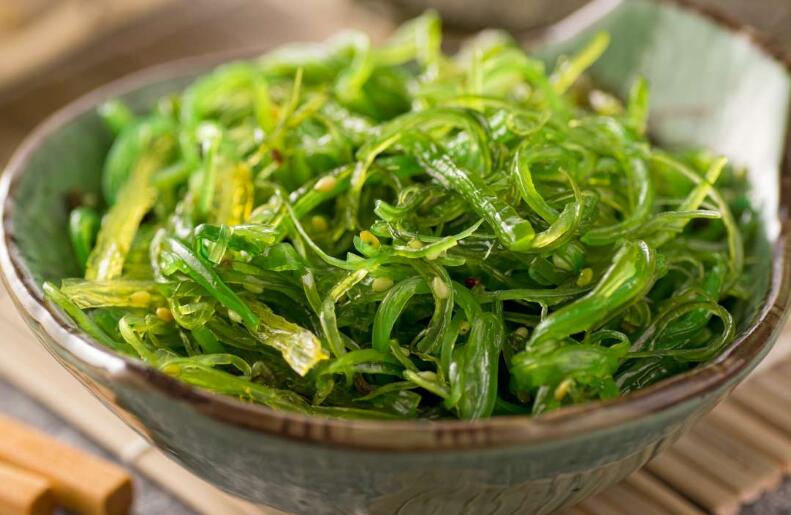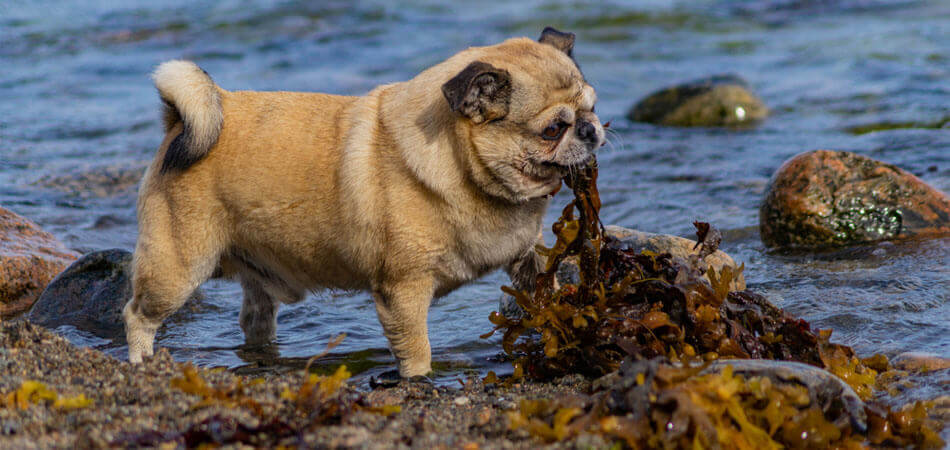Seaweed is a type of nutrient-dense algae that grows in oceans, seas, lakes, and rivers all over the world. There are over 10,000 different species of seaweed that come in a rainbow of colors including brown, red, green, and blue. Seaweed provides a wide range of health benefits for humans. It is consumed by humans in many forms, earning it the nickname “vegetable of the sea.” But can dogs also safely enjoy seaweed? This complete guide will cover whether various types of seaweed can be fed to dogs.
The Nutritional Benefits of Seaweed for Dogs
Seaweed isn’t just a sushi wrapper or a beachside curiosity. It’s a nutritional powerhouse, packed with a variety of vitamins, minerals, and other beneficial compounds. Here’s a closer look at what seaweed can offer to your dog’s diet:
- Omega-3 Fatty Acids: Essential for maintaining a healthy skin and coat, omega-3s also support cardiovascular health and joint mobility.
- Vitamins: Seaweed is rich in vitamins A, C, and E, which are crucial for immune health, vision, and skin integrity.
- Minerals: It’s a source of iodine, necessary for thyroid function, along with calcium, magnesium, and potassium.
| Nutrient | Benefit for Dogs |
|---|---|
| Omega-3 Fatty Acids | Supports skin, coat, and joint health |
| Vitamins A, C, and E | Boosts immune system and maintains vision |
| Iodine | Essential for thyroid function |
| Calcium, Magnesium, Potassium | Vital for bone health and metabolic processes |
Given these benefits, incorporating seaweed into your dog’s diet could potentially enhance their overall well-being. However, it’s important to balance these benefits with the potential risks and to ensure that seaweed is introduced into their diet correctly.
Comparison with Other Dog Foods and Treats
When compared to traditional dog foods and treats, seaweed can offer a unique blend of nutrients not commonly found in standard canine diets.
For instance, the high level of omega-3 fatty acids in seaweed is often only matched by specialized dog foods enriched with fish oil. Similarly, the natural vitamin and mineral content in seaweed can surpass that of many commercial dog treats, which may rely on synthetic supplements for their nutritional value.
In summary, seaweed stands out as a natural, nutrient-rich option that could complement the existing components of your dog’s diet, offering benefits that support a range of bodily functions and overall health.
Can Dogs Eat Seaweed? Types of Seaweed Dogs Can Eat
Now that we understand the nutritional benefits of seaweed let’s explore some specific types of seaweed that are safe and beneficial for dogs to consume:
1. Wakame Seaweed
Wakame seaweed is a healthy food option for dogs. It is rich in vitamins A, B2, B9, C, D, E, and K, as well as calcium, iron, potassium, and omega-3 fatty acids. Wakame seaweed has been proven to be one of the richest plant sources of omega-3 fatty acids, specifically eicosapentaenoic acid (EPA).
Can dogs eat wakame? Yes, the antioxidant-rich wakame seaweed used in miso soup can provide healthy vitamins and minerals for dogs. In moderation, wakame is a good seaweed option.
2. Kelp Seaweed
Kelp seaweed is another safe and nutritious option for dogs. It comprises 25% protein and 2% fat, making it a beneficial addition to a dog’s diet. Kelp contains around sixty different amino acids, vitamins, and minerals, which are vital for maintaining healthy thyroid function and blood circulation in dogs.
Can dogs eat kelp? Yes, in moderation kelp is generally safe for dogs to eat. However, it is essential to note that kelp sourced from US waters may contain high levels of pollutants and toxic chemicals, so it’s best to choose kelp from reputable sources.
3. Nori Seaweed
Can dogs eat nori? Dried nori seaweed sheets are safe for dogs in small amounts. These paper-thin Japanese nori sheets provide protein, vitamins, minerals, and omega-3 fatty acids. Break off tiny strips or squares as a crunchy, low-calorie treat.
However, limiting the amount of nori given to dogs is essential as it may contain trace amounts of harmful chemicals like arsenic and cadmium.
4. Kombu Seaweed
Can dogs eat kombu? This edible kelp is very high in iodine but can be fed to dogs in moderation. It provides glutamic acid for flavor along with fucoidan studied for benefits in joint health.
Kombu Seaweed contains vitamins C, B, D, and E and calcium, iron, magnesium, potassium, silica, and zinc. However, store-bought kombu seaweed pickled in vinegar should be avoided, as it can cause digestive problems in dogs.
Are There Any Risks With Feeding Dogs Seaweed?
While seaweed provides beneficial nutrition, there are some precautions owners should keep in mind:
- Thyroid function: Too much dietary iodine for some dogs may disrupt thyroid function. Use caution when supplementing with high-iodine seaweeds like kelp or kombu, especially if your dog takes thyroid medication.
- Allergies: As with any new food, some dogs may be allergic or sensitive to compounds in seaweed. Start with small amounts and discontinue use if any concerning symptoms develop.
- Contaminants: Only source seaweed from the most reputable places. Seaweed absorbs anything from its growing waters, including heavy metals, chemicals, and bacteria.
- Gastrointestinal upset: Too much dietary fiber from seaweed, especially when introduced quickly, may cause loose stools, gas, or diarrhea. Transition slowly to allow the digestive system to adjust.
- Choking/obstructions: Only feed ground seaweed or very tiny pieces to avoid intestinal blockages. Whole dried seaweed expands when wet and can get lodged.
While moderate seaweed consumption is generally safe for most dogs, there are some risks to be aware of. Consult your vet if any concerning symptoms arise.

How to Safely Introduce Seaweed into Your Dog’s Diet?
Introducing seaweed or any new food into your dog’s diet should be done gradually and with care to avoid any adverse reactions. Here’s a step-by-step guide to safely incorporating seaweed into your dog’s meals:
Step 1: Choose the Right Seaweed
- Opt for organic, low-sodium seaweed varieties such as nori or dulse.
- Ensure the seaweed is free from additives, seasonings, and sweeteners.
Step 2: Start with Small Amounts
- Begin by adding a small piece of seaweed (e.g., a quarter of a nori sheet) to your dog’s food.
- Observe your dog for any signs of gastrointestinal upset or allergic reactions over the next 24-48 hours.
Step 3: Gradually Increase the Quantity
- If your dog shows no adverse reactions, you can gradually increase the amount of seaweed over several weeks.
- The goal is to reach a point where seaweed becomes a regular, but not dominant, part of their diet.
Step 4: Monitor Your Dog’s Health
- Keep an eye on your dog’s overall health and behavior as you introduce seaweed.
- Regular veterinary check-ups can help ensure that the seaweed is not negatively affecting your dog’s health.
How Much Seaweed Can I Safely Feed My Dog?
When first introducing seaweed, start with small amounts and gradually increase over time. Here are some general feeding guidelines depending on the type of seaweed:
- Dried seaweed treats: Only use thin strips or tiny broken-up pieces. Limit treats to 1-2 small pieces 1-2x per week for small dogs, and 2-3 pieces for large dogs.
- Powdered seaweed supplement: Follow package instructions based on your dog’s weight. A general starting amount is around 1/4 – 1 teaspoon added to food 1-2x per week.
- Whole roasted seaweed snacks: Break into small bite-sized bits and limit initial intake to 1-2 times per week.
- Freshly cooked seaweed pieces: Chop finely or puree and mix a few teaspoons (5-10g) into food once or twice a week to start.
Gradually increase portion sizes as your dog’s tolerance allows. But even when acclimated, feeding seaweed more than 2-3 times per week may cause adverse effects. Always follow your vet’s advice about appropriate portion sizes.
What Are Signs of Seaweed Poisoning in Dogs?
If your dog eats too much seaweed, it can potentially cause intestinal blockages, dehydration, and toxicity. Here are some symptoms of seaweed poisoning to watch for:
- Repeated vomiting or regurgitation
- Diarrhea or bloody stool
- Signs of abdominal pain including whining, stretching, or tense belly
- Loss of appetite or refusal to eat
- Increased thirst and urination from dehydration
- Lethargy, restlessness, or weakness
- Rapid breathing or elevated heart rate
- Swollen abdomen or bloating
These symptoms often occur within 12 hours of a dog overindulging in seaweed treats or supplements. Prompt veterinary treatment is vital.
Depending on the amount ingested, the vet may induce vomiting or administer IV fluids and medications to manage seaweed poisoning. In severe cases, surgery could be required to remove an intestinal obstruction.
Call your vet or Pet Poison Helpline right away if your dog shows concerning symptoms after eating seaweed. Timely treatment greatly improves patient outcomes. Prevention is best – carefully monitor seaweed intake.
DIY Seaweed Treats for Dogs
Creating homemade seaweed treats is a fun way to incorporate this nutritious ingredient into your dog’s diet. Here are simple recipes that use seaweed in dog-friendly treats, ensuring you know exactly what your pet is eating.
Seaweed Dog Biscuits
Ingredients:
- 2 cups whole wheat flour (or substitute with a grain-free alternative)
- 1/2 cup rolled oats
- 1 tablespoon powdered seaweed (kelp or dulse)
- 1 egg
- 1 cup unsalted chicken broth or water
Instructions:
- Preheat your oven to 350°F (175°C).
- In a large bowl, mix the whole wheat flour, rolled oats, and powdered seaweed.
- Beat the egg and add it to the mixture along with the chicken broth. Stir until a dough forms.
- On a floured surface, roll out the dough to about 1/4 inch thickness.
- Use cookie cutters to cut the dough into shapes.
- Place the biscuits on a baking sheet lined with parchment paper.
- Bake for 20-25 minutes or until the biscuits are golden brown.
- Allow the biscuits to cool completely before serving to your dog.
Nori Wrapped Treats
Ingredients:
- Nori sheets
- Cooked sweet potato, mashed
- Cooked chicken or fish, finely chopped
Instructions:
- Lay out a nori sheet on a flat surface.
- Spread a thin layer of mashed sweet potato over half of the nori sheet.
- Add a layer of cooked chicken or fish on top of the sweet potato.
- Carefully roll the nori sheet, starting from the side with the fillings.
- Cut the roll into bite-sized pieces suitable for your dog’s size.
- Serve immediately or store in the refrigerator for up to 2 days.
Homemade treats are a great way to control what’s in your dog’s diet and can be a fun activity. However, remember that treats should only make up a small portion of your dog’s overall diet.
Frequently Asked Questions
1. Can Dogs Eat Red Seaweed?
Red seaweed, scientifically known as Rhodophyta, comprises diverse marine algae, including nori and dulse. Humans often enjoy red seaweed in various dishes, but is it suitable for dogs?
Red seaweed is generally safe for dogs when obtained from reliable sources and presented in an unseasoned form. It contains beneficial nutrients such as vitamins and minerals, which can contribute to their overall health. However, avoid red seaweed products with added seasonings, as these may be harmful.
2. Can Dogs Eat Green Seaweed?
Green seaweed, scientifically classified as Chlorophyta, includes varieties like sea lettuce and sea grapes. Known for its vibrant color and potential nutritional value. Can green seaweed be a part of your dog’s diet?
Green seaweed can be a nutritious addition to your dog’s diet when properly prepared and in moderation. It contains chlorophyll, which can aid in detoxification, and vitamins that promote skin and coat health. Always ensure it is plain and free from additives.
3. Can Dogs Eat Brown Seaweed?
Brown seaweed, scientifically called Phaeophyceae, encompasses species like kelp and bladderwrack. It is rich in iodine and has gained attention for its potential health benefits. But is it safe for dogs?
Due to its iodine content, brown seaweed can be a valuable dietary addition for dogs. Iodine is essential for thyroid function, which plays a crucial role in metabolism. However, offering brown seaweed in controlled amounts is essential to prevent excessive iodine intake.
4. Can Dogs Eat Dried Seaweed?
Dried seaweed, often used in sushi and as a snack, is generally safe for dogs in small quantities. It can provide essential nutrients and serve as a low-calorie treat. However, moderation is vital, as excessive consumption may lead to digestive upset.
5. Can Dogs Eat Roasted Seaweed?
Roasted seaweed, a popular human snack, can be shared with your dog occasionally. Its crispy texture and unique flavor may appeal to your pet. Ensure it’s free from added seasonings, especially those containing garlic or onion, which can harm dogs.
6. Can Dogs Eat Seaweed Chips?
Seaweed chips, a crispy and savory snack, can be tempting to share with your dog. Opt for plain, unsalted seaweed chips as an occasional treat. These can be a healthier alternative to traditional dog biscuits.
7. Can Dogs Eat Seaweed Snacks?
Seaweed snacks explicitly formulated for dogs are available in the market. These snacks are designed to cater to your pet’s dietary needs, making them a safe and enjoyable option. Always check the label for any allergens or additives that might affect your dog.
8. Can Dogs Eat Dried Seaweed on the Beach?
While dogs may be curious about dried seaweed they find on the beach, it’s crucial to prevent them from consuming it. Dried seaweed found on the beach can be extremely dangerous and potentially lethal for dogs.
When ingested, dried seaweed can expand in a dog’s digestive system, causing intestinal blockage and potentially leading to stomach rupture. Dried seaweed also contains high salt levels and may be contaminated with hazardous chemicals.
Keeping a close eye on your dog while walking on the beach is essential to avoid any potential risks.
9. Can Dogs Eat Salted Seaweed?
Salted seaweed, often used as a condiment or seasoning, should be avoided when sharing with your dog. Excessive salt intake can lead to sodium ion poisoning, a severe health issue. Stick to unsalted or lightly seasoned varieties if you choose to offer seaweed.
10. Can dogs eat sushi with seaweed?
While plain sushi seaweed is generally safe for dogs, it’s essential to ensure that the sushi does not contain any ingredients, such as soy sauce or wasabi, that can be harmful to them.





